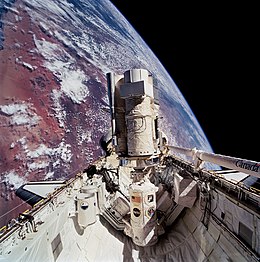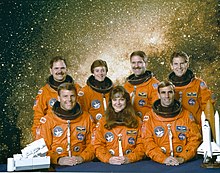STS-67

ASTRO-2 in Endeavour's payload bay
|
|
| Mission type | Astronomy |
|---|---|
| Operator | NASA |
| COSPAR ID | 1995-007A |
| SATCAT no. | 23500 |
| Mission duration | 16 days, 15 hours, 8 minutes, 48 seconds |
| Distance travelled | 11,100,000 kilometres (6,900,000 mi) |
| Orbits completed | 262 |
| Spacecraft properties | |
| Spacecraft | Space Shuttle Endeavour |
| Payload mass | 13,116 kilograms (28,916 lb) |
| Crew | |
| Crew size | 7 |
| Members |
Stephen S. Oswald William G. Gregory John M. Grunsfeld Wendy B. Lawrence Tamara E. Jernigan Samuel T. Durrance Ronald A. Parise |
| Start of mission | |
| Launch date | 2 March 1995, 06:38:13 UTC |
| Launch site | Kennedy LC-39A |
| End of mission | |
| Landing date | 18 March 1995, 21:47:01 UTC |
| Landing site | Edwards Runway 22 |
| Orbital parameters | |
| Reference system | Geocentric |
| Regime | Low Earth |
| Perigee | 305 kilometres (190 mi) |
| Apogee | 305 kilometres (190 mi) |
| Inclination | 28.45 degrees |
| Period | 91.5 min |
 Left to right - Front row: Oswald, Jernigan, Gregory; Back row: Parise, Lawrence, Grunsfeld, Durrance |
|
STS-67 was a human spaceflight mission using Space Shuttle Endeavour that launched from Kennedy Space Center, Florida on 2 March 1995.
Astro-2 was the second dedicated Spacelab mission to conduct astronomical observations in the ultraviolet spectral regions. It consists of three unique instruments – the Hopkins Ultraviolet Telescope (HUT), the Ultraviolet Imaging Telescope (UIT) and the Wisconsin Ultraviolet Photo-Polarimeter Experiment (WUPPE). These experiments will select targets from a list of over 600 and observe objects ranging from some inside the solar system to individual stars, nebulae, supernova remnants, galaxies and active extragalactic objects. This data supplemented data collected on the Astro-1 mission flown on STS-35 in December 1990 aboard Columbia.
Because most UV radiation is absorbed by Earth's atmosphere, it cannot be studied from the ground. The far and extreme ultraviolet region of the spectrum was largely unexplored before Astro-1, but knowledge of all wavelengths is essential to obtain an accurate picture of the universe. Astro-2 had almost twice the duration of its predecessor, and a launch at a different time of year allowed the telescopes to view different portions of the sky. The mission was designed to fill in large gaps in astronomers' understanding of the universe and lay the foundations for more discovery in the future.
On the Middeck, science experiments include the Protein Crystal Growth Thermal Enclosure System Vapor Diffusion Apparatus-03 experiment (PCG-TES-03), the Protein Crystal Growth Single Thermal Enclosure System-02 (PCG-STES-02), the Shuttle Amateur Radio Experiment-II (SAREX-II), the Middeck Active Control Experiment (MACE), the Commercial Materials Dispersion Apparatus Instrumentation Technology Associates Experiments-03 (CMIX-03) and the Midcourse Space Experiment (MSX).
...
Wikipedia

